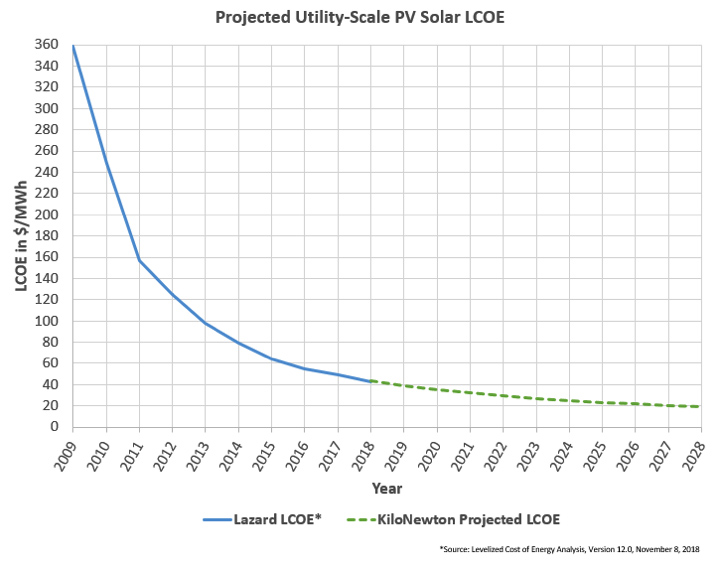Utility-Scale Solar Trends Project 50% Lower Costs in Just 10 Years
/Matthew Gagne, GIS/Renewable Energy Analyst, and Ehtesham Tariq, Mechanical Engineer, from Kilonewton LLC write:
In the last 10 years, renewable energy has quickly become competitive with conventional generation sources that have historically dominated the energy market. Renewables have traditionally relied on incentives at both state and federal levels in the United States to get a foothold in the market. But the levelized cost of energy (LCOE) for utility-scale photovoltaic (PV) solar and wind has dropped significantly according to the Lazard Levelized Cost of Energy Analysis released earlier this week, even without consideration of those incentives. While subsidies remain a factor in the renewable energy economic picture, utility-scale PV solar and wind energy are competitive with conventional generation. We expect that trend to continue as renewable technology improves, supply chains reduce costs, and market penetration increases.
The main factor for LCOE for utility-scale PV solar and wind energy has been capital costs, or the cost of manufacturing and installation of projects. The LCOE for solar and wind, as stated by the US Energy Information Administration earlier this year, is affected proportionally by the capital cost of generation capacity. Capital costs for PV solar and wind have historically been high when compared to conventional generation. However, renewables have an inherent advantage over fossil fuels generation sources in that the fuel is free from massive extraction, transportation, and storage costs, and operations and maintenance is comparatively low.
Subsidies have helped reduce those costs. But reliance on those subsidies has been somewhat problematic. Wind has been especially affected, as the periodic expiration and renewal of the Production Tax Credit at the federal level has led to economic fluctuations in the industry. However, the subsidizing of PV solar and wind and an increasing demand for renewable energy has allowed for the development of a robust competitive market, resulting in reduced supply chain costs and improved technology.
This is reflected in the Lazard report. The report shows a steep decrease in the LCOE for PV solar, with a drop of 88 percent in the last 9 years and a compound annual growth rate (CAGR) of 21 percent. The LCOE for wind energy has a similar trend with a decrease of 69 percent in the last 9 years and a CAGR of 12 percent.
While incentives are still a large component of the renewable energy market, the Lazard report shows that its influence, especially with utility-scale PV solar, is waning. Incentives have much more of an effect on residential PV and wind energy.
When compared to conventional generation such as nuclear and coal, the Lazard report shows that utility-scale PV and wind have a much lower LCOE. Much of this is due to increased competition in the market as well as capital cost factors, such the supply chain and improved technology. While wind has been competitive since 2011, according to Lazard, utility-scale PV solar has only been competitive in the last couple of years.
We expect the trends shown in the Lazard report, especially with utility-scale PV and wind, to continue in the next 10 years. The Department of Energy’s SunShot 2030 goal is to cut the LCOE of utility-scale PV by an additional 50% by the year 2030. Following the current trend, we expect the LCOE for PV solar will reach the goal in 2028. The SunShot program, which began in 2011, has been instrumental in reducing the cost of LCOE for PV solar without subsidies. The solar industry achieved the initial SunShot 2020 goal of $0.06 per kilowatt-hour for utility-scale PV 3 years ahead of schedule.
Our analysis is based on several factors. Capital costs will continue to reduce, while technology will continue to improve. Also, the implementation and advances in energy storage will be crucial to wind and solar. The wind doesn’t always blow and the sun doesn’t always shine during peak demand, resulting in curtailed wind energy production and clipped solar production. The SunShot 2030 goal includes integration of PV solar with storage as an integral part of reducing the LCOE by half. The Lazard analysis cites the ability for energy storage to not only capture otherwise lost energy, but also share interconnection and inverter costs, as reasons why the LCOE of utility-scale PV solar and wind may decrease in the future. In addition, the trend of mothballing and not replacing older conventional generation facilities will only increase demand and market penetration for renewables.
Photo By Matt Pankuch




















